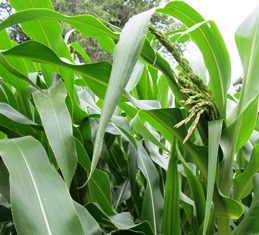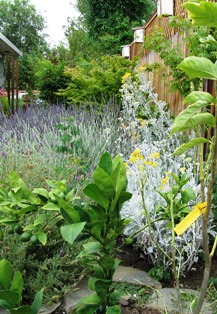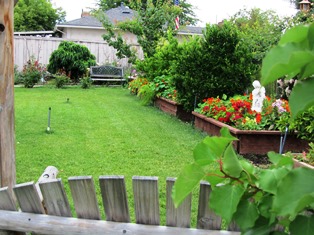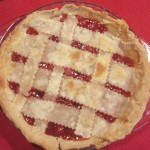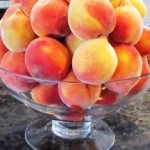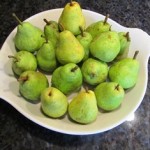Archive for July, 2017
Harvesting Garlic
Now that it’s the last week of July, the garlic in my Henny Penny Farmette garden is showing signs of maturation. When the bottom stalk leaves turn brown and dry, it’s an indicator that the bulbs beneath the soil are ready for harvesting.
Garlic is easy to grow, harvest, cure, and store. If you like to cook, you already know how important garlic is as a culinary staple. Since it doesn’t require much space, you can grow it in a large pot or flower box on your patio. It’s well worth your time and effort.
The leaves of a garlic plant sprout from the bottom of the stem upward. The oldest bottom leaves will indicate maturity of the bulbs.
Use a fork to carefully loosen soil around the base of each garlic plant. It’s a good idea not to pull from the stems as they might snap. You don’t want to bruise or otherwise damage the garlic bulbs.
Once the plants are harvested, you’ll need to cure them by drying them in a cool, dark place. You could also tie them by their stems in small allotments and hang in protected shed or ventilated closet where the air can circulate around the bulbs.
- Cloves of garlic ready to be peeled and prepared for cooking
When the garlic has been cured, remove any remaining soil. Braid the stems to hang the bulbs in your kitchen for easy access when cooking (these braids also make great gifts to friends who cook). Or, leave about 1/2 inch of stem in place before cutting off the rest and storing the garlic in a cool, dark, place.
Softneck Garlic: This type of garlic is preferred for braiding and includes the varieties of Creole, artichoke, and some Asian types of garlic. Softneck garlic grows best where winters are mild and this type of garlic stores for a longer period of time than hardneck types.
Hardneck Garlic: If you want garlic adaptable to cold winter climates and a taste that is closer to wild garlic, this is the type of garlic of choose. It includes the rocambole, purple stripe, and porcelain varieties.
_______________________________________________________________
If you enjoy reading about farmette topics, gardening, and keeping chickens and honeybees, check out my series of cozy mysteries from Kensington Publishing in New York.
Click on this link: http://tinyurl.com/ya5vhhpm
Click on this link: http://tinyurl.com/yd7pz7af
Edible Landscape: Our Garden of Gentle Disorder
I’ve long been enamored of the traditional French jardin potager or ornamental, vegetable kitchen garden. The kitchen garden has its roots the medieval jardin de curé, described by garden author Jean-Paul Collaert in Kitchen Gardens of France, by Louisa James (Thames and Hudson 1999), as a “garden of lines . . . not dabs of color” as opposed to the English cottage garden and the traditional vicarage garden.
Most potagers grow the traditional four types of plants: vegetables, fruit, flowers, and herbs. What I love is the revival of interest worldwide in heirloom fruits and vegetables, which are perfectly suited for a kitchen garden. On my farmette, I grow plants almost exclusively from heirloom seed.
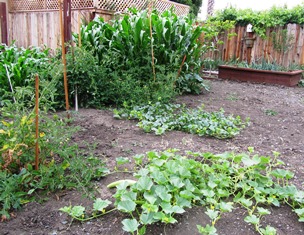
Corn, cucumber, and tomatoes share ground space; onions, garden peas, and eggplants thrive in boxes, table grapes spill over the fence
The medieval jardin de curé has been characterized by scholars as having plants in distinct beds laid out along formal lines (the Latin cross was popular). Gardening plots were defined by ge0metric shapes that could be quite complex (for example, the historic knot garden). Plants included herbs and flowers (many for medicinal uses), vegetables, berries, fruit trees, and ornamental trees and shrubs. This type of garden could be rustic or highly formal and could be found throughout France, from small farms and cloisters to country estates.
Our farmette garden has characteristics of the jardin potager and also the jardin de curé, although it could not be described as a true representation of either.
When we first moved to the farmette, we created and followed a master plan. The acreage follows a large rectangular-shape perimeter with our small house situated in the middle. Behind the house, a lawn is lined with gravel pathways. The pathways are dotted with boxes of herbs and flowers, mint, and berries. Between the boxes, the apricot, cherry, apple, fig, and persimmon trees are flourishing and producing bountiful crops.
In chaotic disorder, the beds of French perfume lavender and Spanish lavender that we planted have taken over one side of the property (much to the delight our honeybees), effectively erasing any lines that might have been obvious in an early layout. Interspersed with the lavender beds are iris, hydrangea, roses, lemon trees. Where the lavender turns a corner, bamboo creates a privacy screen, and then the fruit and flower-lined gravel path continues to the chicken house.
We moved dirt from the back half of the property and built a retaining wall along an L-shaped gravel path leading to a vegetable garden. Both sides of the path are lined with trees–apricot, pear, and pomegranate. On one side under a massive elm is a bed containing white geraniums and a variety of rose bushes.
We are following a plan for our own vision of a potager and, although I wish it had more of the lines of the medieval jardin de curé, our garden has the appearance of gentle disorder while being a prolific producer, in short, an edible landscape.
I love this living tableau. The appearance of the garden and grounds changes with the cycles of the seasons. Also ever-changing are the types of wildlife and songbirds frequenting the fountains and foraging on the fruits. There’s always something new to discover.
__________________________________________________________________
If you enjoy reading about farmette topics, gardening, and keeping chickens and honeybees, check out my series of cozy mysteries from Kensington Publishing in New York. Click on the link.
A HIVE OF HOMICIDES
Perseverance with Portable Pauses Pays Off
Just before Thanksgiving 2016, I was approached by my editor to write a nonfiction book about guided meditation. The deadline was extremely short (a few weeks). Still, I loved the subject and was up for the challenge. But there was a problem.
I had previously agreed to plan and cook Thanksgiving dinner for my family and my married daughter’s family. What happened next threw me entirely off my game. I’d never missed a book deadline, but I feared I might this time. Why?
My daughter was rushed into the hospital for emergency surgery even as her husband battled pneumonia. Suddenly, he, too, had to have emergency surgery.
Deeply concerned for them, I comforted their kids and looked after their dogs even as I worked on the book, prayed for a positive outcome for both parents, and figured out what to cook for our holiday meal. It seemed impossible I could do it all, but brief meditations (taking portable pauses) during quiet moments helped me to focus.
When the drama finally ended, the two patients had returned home to recover from their surgeries, the kids worries had subsided, and I had put a traditional holiday meal on the table with the help of the kids who wanted an extra special Thanksgiving for their parents. We even whipped up some pumpkin pies.
My understanding editor gave me three more days to finish the book . . . and I did. I felt bad about missing my original deadline, but I had plenty of reasons to give thanks.
MY POCKET MEDITATIONS is due to be released on August 8, 2017 from Adams Media/Simon & Schuster. If you have trouble finding time to meditate, this book will guide you into a quick meditation . . . even if you can find only a few minutes to dive deeply within.
If you purchase and read a copy, I hope you’ll post an online review. Here are some links to the book.
http://www.indiebound.org/book/9781507203415
https://www.barnesandnoble.com/w/my-pocket-meditations-meera-lester/1125160811?ean=9781507203415
Swimming in Fruit
Our cherry trees became so heavily laden with fruit this year I couldn’t work fast enough to make the fruit into cookies and pies and jars of jam, conserve, and chutney.
What fruit the birds and squirrels didn’t devour ended up drying on the trees and looking like ornaments. I’m heartened that at least the wildlife will have something to forage on through fall and winter.
The apricot trees did a massive drop of their fruit and seemingly all at once. I made more jam than we’ll probably eat, dried some, and gave away more than a few full buckets of cots to neighbors and friends. I also had to do a messy cleanup of fruit on the ground.
In the cycle now are the summer peaches; so, here I go again . . swimming in fruit.
Next year, I’m going to get my act together early with teams of backyard pickers who can help me remove the fruit, divide it, and distribute it. Right now, however, I’ve got peaches to pick and preserve. The summer pears and figs will be next.
I’m not complaining; I’m enthralled that all this bounty is due to the work of our industrious little honeybees. All this fruit and I haven’t even mentioned finding time to harvest honey. Yet, the bees don’t stop, so neither will I.
________________________________________________________________
If you enjoy reading about farmette topics like keeping bees and chickens, caring for an orchard, or growing heirloom herbs and vegetables, check out my mystery series from Kensington Publishing (due out September 26, 2017).
These novels feature a whodunnit for you to solve and are filled with farming facts, trivia, and delicious recipes. The novels and my other books are available in traditional and online bookstores everywhere. See, http://tinyurl.com/yb42zd2d
Celebrating the Fourth–Hankering For Nostalgia
On the farm where I grew up in central Missouri, we celebrated the Fourth of July with a fish fry. We caught blue gill, bass, crappie, and catfish in my grandfather’s stocked ponds or from nearby Perche Creek.
After my brother, cousins, and I played games until dark and then chased fireflies, my grandmother would set out dessert–a simple blackberry pie, shortcake and berries with homemade ice cream, or a pineapple upside down cake. A grownup would surprise us kids with sparklers that we would light and wave as we ran around in the dark.
Feeling nostalgic for those old days and ways of celebrating, I’m going to shuck and cook corn on the cob and grill some salmon with fresh veggies from the garden for this–our eighth celebration of this holiday on the farmette. There’s a ton of summer squash that I’ll douse with olive oil and sprinkle with seasoning before grilling.
For the salmon, I make a easy-peasy mango-lime-cilantro salsa. Chop red onion and red and green bell pepper. Cube slices of fresh mango. Take a handful of cilantro that’s been tightly rolled and chop it into ribbons. Mix everything together, sprinkle with sugar, and generously drizzled with fresh lime juice. Serve well chilled over the grilled salmon.
I’ve already whipped up a pineapple upside down cake and baked it in my 10-inch cast iron skillet. To save time, I used a yellow cake mix and added a dash of rum and pineapple juice for flavor. Recipe is below.
QUICK PINEAPPLE UPSIDE DOWN CAKE
Ingredients:
1/2 cup plus 2 Tablespoons butter
1 1/4 cups sugar
7-8 slices of canned pineapple
7-8 maraschino cherries
1 box yellow cake mix
1 Tablespoon dark rum
1/8 cup pineapple juice
Directions:
Preheat oven to 350 degrees Fahrenheit
In a cast iron skillet over medium heat, melt the butter. Add the sugar and stir until the sugar turns light brown (roughly 5 to 7 minutes). Remove from heat. Carefully lay in the pineapple slices. Place a cherry in the center of each fruit ring.
Make the cake according to directions on the box. Add the rum to the batter. Pour over the pineapple slices in the skillet.
Place the skillet on the middle rack in the oven and bake the cake at 350 for 30-40 minutes. Guard against over browning of the top. If necessary, lay a layer of aluminum foil over the cake near the end of the bake time. Use a knife around the cake edges to loosen from the skillet. Turn upside down onto a cake plate. Enjoy.
_______________________________________________________________
If you’re interested in farmette topics and storytelling, check out my Henny Penny Farmette series of mysteries. All three books in the series are available in numerous formats and can be ordered from Amazon, Barnes and Noble, and elsewhere online as well as from traditional bookstores everywhere.
These cozy mysteries make great summer reading and they include delicious recipes, tips for keeping bees and chickens, and facts and tidbits about growing heirloom vegetables and herbs.
Please see more at http://tinyurl.com/ya5vhhpm
 Facebook
Facebook Goodreads
Goodreads LinkedIn
LinkedIn Meera Lester
Meera Lester Twitter
Twitter








